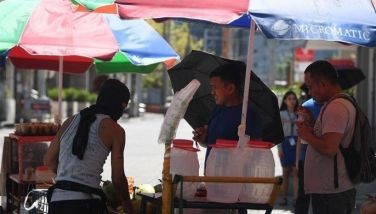More jobless Pinoys amid stellar growth
MANILA, Philippines - Joblessness rose to a three-year high in April amid record economic growth as new graduates flooded the job market while unfavorable weather conditions stymied hiring in the agricultural sector, officials said yesterday.
Based on the National Statistics Office (NSO) Labor Force Survey, unemployment reached 7.5 percent in April, up from 6.9 percent in the same period last year. The current unemployment rate was the highest since the eight percent recorded in 2010.
Sought for comment, President Aquino read a text message from Socioeconomic Planning Secretary Arsenio Balisacan attributing the decline in employment to effects of the scorching summer heat on agricultural productivity.
“It was reported that farmers delayed their planting in April. Unfortunately, the survey also was done in April. So, at the time they conducted the survey, there was a coincidence in the delay,†Aquino explained.
The country’s economy expanded 7.8 percent in the first three months of the year, outstripping China to make it Asia’s fastest-growing economy.
For Labor Undersecretary Danilo Cruz, the unemployment rate is traditionally high during April due to the large number of young people joining the labor force after graduating from college or high school.
“There is a usual increase in the number of workforce in April because of the high number of new graduates, that is why the increase in number of jobless is expected,†Cruz said.
In the NSO survey, the number of employed nationwide went down to 37.819 million in April from 37.840 million in the same period last year.
The survey also showed that the number of jobless people in April ballooned to 3.086 million from 2.8 million last year.
There were more males (61.4 percent) than females (38.6 percent) among the unemployed. Most of the unemployed belong to the 15 to 24 age group and are mostly high school and college graduates.
In the NSO report, the number of agricultural workers declined by 624,000 from 12.468 million in April 2012 to 11.844 million in April this year.
Workers in the services sector remained the largest group, comprising more than half or 52.6 percent of the total, while workers in the agriculture sector comprised the second largest group, accounting for 31.3 percent of the total employed. Workers in the industry sector made up 16.1 percent.
Quality employment
But while job figures have dropped, the quality of employment has significantly improved, according to Labor Secretary Rosalinda Baldoz.
“What is very encouraging in the results is the fact that the overall quality of employment continues to improve considerably, with persons in full-time employment growing by 15.3 percent, or 3.194 million, and persons in part-time employment decreasing by 18.9 percent, or 3.063 million,†Baldoz said in a statement issued from Geneva where she is attending the 102nd International Labor Conference.
“As a consequence, the mean hours of work has vastly improved from 39.2 hours a year ago to 41.8 hours in April 2013,†she added.
Citing survey results, Baldoz said wage and salary employment during the quarter was up by 619,00 while the number of self-employed dropped by 143,000 and unpaid family workers by 398,000.
“This tells us that the Millennium Development Goal indicator on employment to reduce poverty, in terms of the ratio of the self-employed and unpaid family workers to total employment, is narrowing; wage and salary and full-time employment is expanding; and mean hours of work is increasing,†she explained.
She noted that employment growth was particularly robust in private and government establishments. Together, private and public sector employment expanded by 667,000 from a year earlier, she said.
Underemployment, she said, decreased from 19.3 percent last year to 19.2 percent in April this year. But she said the latest job data should be viewed as a challenge to government and its private sector partners.
“Thus, if the low earnings can be directly related to our workers’ need to acquire additional skills or to upgrade their skills, which could be a reason why it is difficult for them to access other job opportunities, the DOLE’s immediate response is to offer them the Training for Work Scholarship of the TESDA,†she said.
University of the Philippines School of Labor and Industrial Relations professor Rene Ofreneo said the government needs to do more to create jobs and make the country’s strong economic growth felt by more Filipinos.
“The message of the statistics is clear. The economy is growing but it is not translating to jobs for the people. Not enough jobs are being created,†he told The STAR.
To create more jobs, he said the government should give more attention to the agriculture and manufacturing sectors. He added the government should also address the high cost of power as well as rampant smuggling.
“Urban poor and rural poor areas are increasing. It cannot be business as usual (for government) anymore,†he said.
Diversification
National Economic and Development Authority (NEDA) assistant director general Rosemarie Edillon said the country may have to explore agricultural job diversification, which may involve putting greater emphasis on the coconut industry.
The coconut industry was the third highest employer in the agricultural sector in the ’80s. The industry weakened due to softening of global prices, natural disasters, lack of state support, and even negative political issues. Currently, coconut workers are among the lowest paid.
She expressed hope the administration would still be able to meet its job targets.
“The seasonal character of the agricultural sector, some alteration in their planting calendar due to the natural disasters such as the El Niño phenomenon, contributed to the decline,†Edillon said in a press briefing yesterday.
She said weakness of the agriculture sector was offset by the strength of the industry and services sectors, which added 604,000 jobs in the same month.
“Thus the net job loss for April was approximately 21,000 jobs,†she added.
In Laguindingan, Misamis Oriental where he inaugurated an airport, Aquino also largely blamed the weather for the unfavorable employment data.
“There is this perception that if it’s too hot and there are unfavorable weather conditions, the farmers do not want to plant,†he said.
“As you know, farmers will always have the weather dictating their planting cycles. There have been offsets, improvements in the industry and service sectors; wage and salary workers working full-time increased in both sectors,†he pointed out.
“Therefore, the net result was a net job loss of 21,000. Can I just add that in the two years between 2010 and 2012, the net new jobs generated was a total of 1.57 million.â€
“The number of new persons employed in the wage and salary category – this category is a widely used indicator of quality jobs – increased by 1.99 million during the same period,†he added.
“You know, there’s a suspicion that when a respondent in a survey is asked as to his employment status, there have been many who say they’re self-employed, which might be a euphemism for not employed,†he said.
DOLE’s Cruz also said that contrary to expectations, the recent elections did not create many jobs.
“During elections, the Commission on Elections banned many government infrastructure projects, thus there is low hiring rate in the construction industry,†Cruz explained.
“Not even the election spending can boost employment since the election period is very short and temporary. A lot of money may circulate, but it does not mean additional jobs for the people,†Cruz added.
Meanwhile, Vice President Jejomar Binay said the Philippines should take lessons from Germany’s dual vocational system to curb unemployment.
“We hope we can apply a similar scheme in the Philippines, especially with the implementation of the K-12 program and we look forward to a possible cooperation with Germany on this in the future,†Binay said.
The vice president recently had a working visit to Germany where he met with Labor Minister Ursula von der Leyen.
“They are offering us how we can adopt it and how we can use it, especially with our K-12, K-12 plus two years. This vocational will be included in dual system,†Binay said.
Binay said the German dual vocational system combines apprenticeships in a company and vocational education at a vocational school.
He said that in-firm training takes from two to 3.5 years after which trainees receive certificates.
Binay also said he and the German official are eyeing a bilateral agreement on equivalency of academic degrees.
“We believe such an agreement would lead towards an eventual mutual recognition of degrees for professional purposes,†Binay said.
Currently, there is an existing tie-up between the University of Santo Tomas and the International University Cooperation Education (iUCE). Filipino students enrolled under this program have the option to continue their studies in Germany. With Louella Desiderio, Delon Porcalla, Jose Rodel Clapano
- Latest
- Trending






























